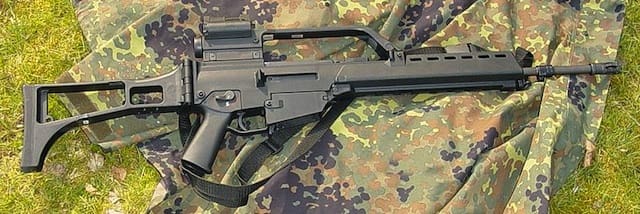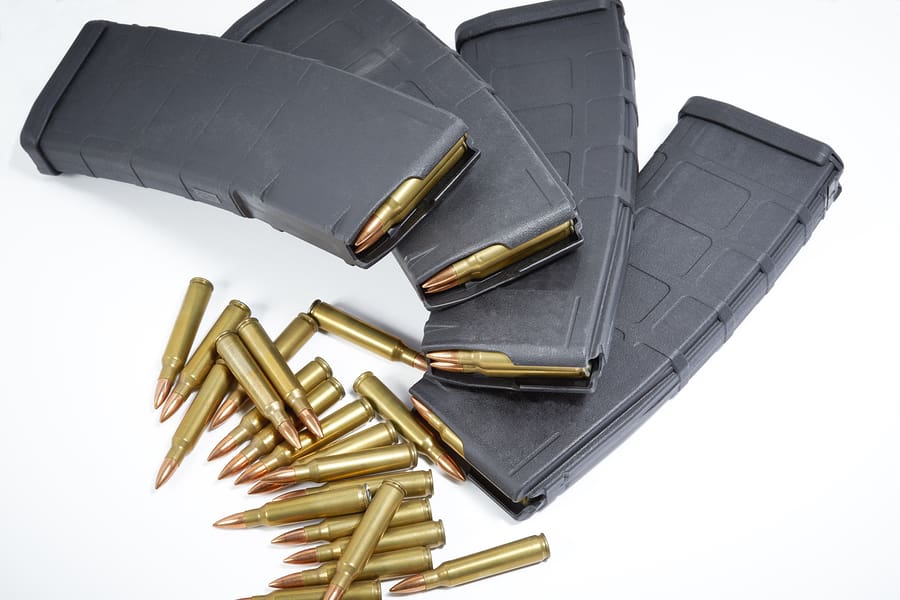Back in January 2011, TTAG reported that box-fresh H&K G36’s had found their way into prohibited areas of Mexico. We wondered if when the guns would “seep” to the cartels. borderlandbeat.com reports that we’re not the only ones making that connection, now, in light of the 43 murdered students in Iguala. [Full report after the jump.] This will do nothing to help the German gunmaker, rumored to be up for sale thanks to financial difficulties. In fact, we’ve heard that the Freedom Group is interested. Meanwhile, in Mexico . . .
A newspaper in Germany reported that 36 German guns were seized from the municipal police in Iguala, Mexico following the September disappearance of 43 student protesters, illustrating the deep ties of these police to the local criminal group Guerreros Unidos.
According to daily newspaper Die Tageszeitung, three dozen Heckler & Koch G36 assault rifles — in addition to Italian and US weaponry — were among 228 firearms Mexican prosecutors confiscated from police installations in Iguala, in the southern state of Guerrero.
The Mexican government does not issue German weaponry to its armed forces or police. This leads to the presumption that the weapons came from the Iguala police’s criminal overlords, the Guerreros Unidos.
Authorities have not yet established whether the German weapons were used to attack the student protesters, who were apparently murdered by members of the Guerreros Unidos working in collaboration with municipal police, possibly on the orders of the local mayor and his wife.
The whereabouts of all but one of the bodies remains unclear and debate continues over where and how the alleged murders of the students occurred.
Exporting German weapons to states engaged in an armed conflict or with poor human rights records is expressly prohibited. However, according to Germany’s Federal Office for Economics and Export Control (BAFA), Heckler & Koch was allowed to export some 9,000 G36 assault rifles to Mexico between 2006 and 2009 with the stipulation that they not be made available in the conflict-ridden states of Guerrero, Jalisco, Chiapas and Chihuahua.
Despite this ban, a journalist with Radio Netherlands cited by Sin Embargo has reported that G36 rifles were used in a previous state police attack on student protesters in Guerrero, in 2011, and that these guns have also showed up in the hands of police in Chihuahua.
According to German peace activist Jürgen Grässlin, holes in Germany’s monitoring system have helped facilitate the black market trade in weapons from this country, which is the world’s third-largest arms exporter. German arms manufacturer SIG Sauer has also come under fire for illicit arms exports.
InSight Crime Analysis
The weapons are a good place to start when analyzing levels of collusion between security forces, police and organized crime. A Mexican intelligence agent, speaking on condition of anonymity, told InSight Crime that his agency counts five levels of collusion between police and criminal groups.
Level 1: The police simply allow criminal groups to act without interfering.
Level 2: The police accept (or demand) payment for allowing criminal groups to act without interfering.
Level 3: The police protect criminal groups and their enterprises for a fee.
Level 4: The police work for the criminal groups and their enterprises for a fee.
Level 5: The criminal group runs the police as part of the criminal enterprise.
The discovery of the German weapons appears to make for a Level 5 situation, the intelligence official said.
To be sure, the fact that the Iguala municipal police were in possession of prohibited firearms suggests that they acquired them from criminals with access to black market weaponry — most likely the Guerreros Unidos. If this is the case, it indicates the deep integration of the Iguala police into this drug gang, which may have seen the police as their “men” who they needed to better arm.
In some ways, this is the reverse of what is more commonly seen with arms: security force weapons falling into the hands of criminals (weapons recovered from Mexican cartels have been traced to Guatemalan and Honduran military stocks). That would be something closer to a Level 3 scenario.
In this case, the police were the recipients, rather than the providers, of black market weapons. Mexico’s municipal police forces tend to be underfunded and lack adequate equipment, which may have incentivized the illegal purchase of high-power firearms for what the criminal group considers part of their armed wing.
The weapons are just one piece of evidence of a Level 5 collusion. In this rather blatant case, the police are thought to have literally corralled the students and handed them to the criminal group. Normally, the evidence is not so stark; in the less obvious cases, a peek at the guns could be a good way to start figuring out who is working for whom.





From what I’ve heard, the G36 starts losing accuracy as the barrel heats up in rapid fire.
If that’s true, once they use them they won’t want more.
Maybe it loses accuracy after 5 magazines full auto at 200 yards… I doubt any of those criteria were met when they massacred students in the school.
You’re a special kind of stupid aren’t you?
oh my god, you are an idiot. please do not comment any more. PLEASE
The cartels and their police BFFs are firearms fashionistas. Hence their love of FN FiveseveNs and 50 cal Barretts.
Gotta love those crazy Mexicans! “We don’t need no stickin badges!” Priceless, and all to get money from gringos for drugs.
It goes far beyond drugs at this point.
The cartels are in business with the Mexican military, police, and government. Most people have no idea the level of Mexican government complicity and corruption, all the way up to the highest level (president’s office).
Mexican Presidents are limited to one, six-year term, so they set out to steal as much as possible within that time-frame. And that’s the truth. Mexico is mob-owned, from top to bottom. It’s like Chicago, but warmer and with better tacos.
To be fair, Chicago has some great tacos. And our mob is a little more professional.
Is it possible that some of the G36s reported were actually “indigenous” FX-05s? The Mexican rifles look just like a G36 at a passing glance. Either way… No bueno down there. Maybe they should try banning guns or something.
The mexican govt does, indeed, issue german weapons to it’s police and troops. They’ve done so for years. You can hardly look at a photo of a group of mexican soldiers or cops without spotting a g3 of hk21 somewhere in the mix.
Seriously, the government down there is even more corrupt than the cartels (who at least admit that they’re criminals) and absolutely nothing they say should be taken at face value. Ever.
First off, if you sell guns to Mexico the firearms will end up in the hands of criminals. Why? Because firearms are banned from the citizens. Mexico has many firearms which were not sold directly, I wonder where those came from, how could it happen!? duh. The best way to begin a method to repair Mexico is to make the Panama Canal into a huge moat full of saltwater crocodiles and stand guard at the edges with machine guns 24/7. Please don’t harm the crocodiles!
Mexico is a perfect example of how prohibitionist laws actually serve to encourage smuggling and illicit sales of prohibited commodities. Mexican smugglers are very, very good at what they do.
In the US bootlegers were notorious for covertly funding prohibitionist ministers’ efforts to ban “demon rum”. Prohibition was good for their business.
Exactly. Prohibition is as effective as gun control. We can’t even keeps large amounts of drugs out of state prisons.
Just in an interest of keeping the facts straight guns are not banned in Mexico. Highly regulated and oppressed in their use but private gun ownership is legal in Mexico though it is not recognized as a right.
Was eric holder involved?
Ask Al Sharpton. He gives the orders now.
36 G36… hmm… how many it would be for a HK416??
Take a second to smell the roses. Welcome to the world that truly is. It’s time for a change of direction in policy concerning the top/down conflicts in Mexico.
Problem is I can’t seem to find any politicians who are up for the task. On the other hand, cartels have proven time and again, no one is untouchable. Sad reality that it is…
Let’s all try to be thankful for our first world problems, this holiday season….
“… cartels have proven time and again, no one is untouchable.”
I agree … and unfortunately cannot think of any solution.
I know a quick fix for this issue, give the guns to me. I will make sure that they no longer reside in any Mexican state.